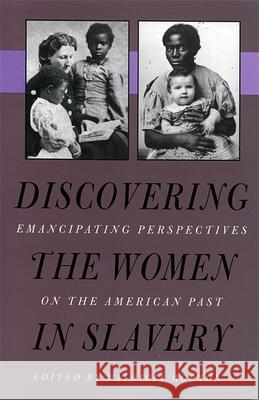Discovering the Women in Slavery » książka
Discovering the Women in Slavery
ISBN-13: 9780820317571 / Angielski / Miękka / 1996 / 336 str.
"Discovering the Women in Slavery" is a collection of fourteen original essays on women's experiences of slavery in America, researched and written from gender- and women-focused perspectives. The essays discuss not only slave women, but also plantation and slaveholding mistresses and free women of color, in contexts ranging from the colonial era to the Civil War South. Intended for wide readership, this book is especially designed to bring attention to the new questions and findings about American slavery that are engendered by today's exploration of the experience and roles of the women generally left invisible, stereotyped, or both, by conventional American slavery history.
As Patricia Morton notes in her historiographical introduction, "Discovering the Women in Slavery" continues the advances made, especially over the last decade, in understanding how women experienced slavery and shaped slavery history. In addition, the collection illuminates some emancipating new perspectives and methodologies. Throughout, the contributors pay close attention--over time and place--to variations, differences, and diversity regarding issues of gender and sex, race and ethnicity, and class. They draw on such qualitative sources as letters, novels, oral histories, court records, and local histories as well as quantitative sources like census data and parish records.
The collection is structured in two sections that demonstrate, through complementary approaches, how the diverse and intersecting worlds of women and slavery can be discovered. The first section comprises pioneering individual case studies. One essay, for example, uses racist sources to shed light on a former slave woman's major contribution to the South's internal rebellions against the Confederacy. Another discusses a mistress who, by her own initiative, first became a slave owner while her husband was at war. In the second section, which presents group studies, one finds equally pathbreaking explorations of such topics as the religious experience and culture of early slave women and also the clothing and self-adornment of enslaved and free African American women as material culture artifacts and evidence. All of the essays in the collection point to additional sources for study and research.
Reconstructing the histories of women who struggled to shape their own lives and who, in the context of slavery and its legacies, often struggled tragically against each other, this collection richly contributes to the humanization of America's slavery past.











